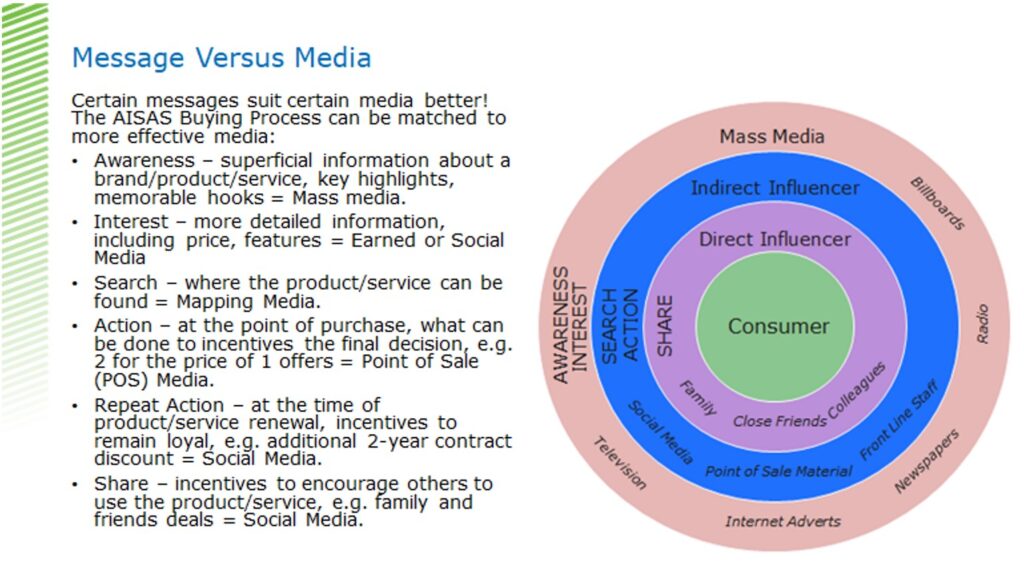Part II: How to Market the Right Business Model
This article is Part 2 of our two-parter on revenue growth from marketing effectiveness. If you haven’t read Part 1 yet, please click here.
Using Inbound and Outbound Media Effectively
When it comes to promotional activities, we often find significant flaws in the way companies allocate their spend. The majority spend 90% on the up-front awareness messages in conventional outbound media, with very little spend made on the other stages of the buying process. Consumers are often more open to influence at the active evaluation (search and interest) and loyalty (repeat action/advocate/share) stages.
There are different consumer journeys to reach your product depending on the industry. For example, loyalty is much more important in the automobile industry than awareness. Therefore, there must be a huge bias towards Repeat Action and Share messages.
There are 4 types of media at the highest level – paid, owned, earned, and shared.
- Paid and owned media is referred to as outbound media, where content is pushed onto the consumer.
- Earned and shared media is referred to as inbound media. Rather than ‘invading’ a customer’s space with paid adverts, the content is available when a customer is in active evaluation and is received in a much more positive manner.
Inbound media is vital in the interest/active evaluation stages for established products and is nothing short of vital in new product launches. In an increasingly online world, inbound media is having a profound effect on marketing. Unfortunately, many companies are weak in managing this.
The Right Media for The Right Message
Not only do clients tend to spend too much on awareness messages, whatever messages they do use can also end up being disseminated in the wrong media. For example, a bank we worked with in Thailand was planning to cross-sell an insurance product to their credit card holders via a billboard campaign. However, most people seeing the billboards would not even have the bank’s credit card. It would be better for the bank to spend on direct mail leaflets included in the credit card statement.
The chart below maps the AISAS (Awareness, Interest, Search, Action and Share messages) buying process to the most appropriate media types. A large part of improving marketing effectiveness is understanding where a company’s products and/or services are in their life cycles, determining the best fit messages to support their sales, and mapping these to the most appropriate media types.
However, we still need to make sure that companies are getting a bang for their buck. This is where the concept of Cost Per Impression (CPM) comes into play. CPM allows companies to identify the true cost of reaching the consumer, by allowing them to identify which media is more cost effective (in terms of impressions). In the long run, they can track variances in the message and media mix versus the uptake in sales, and start to home in on the most cost-effective combinations.
For one of our clients, we came up with 14 different standard campaign configurations after some experimentation that represented the best mix of media by key messages and type of event. With another client, we delivered a 15% improvement in marketing spend through better alignment of message to product life cycle and media.
Marketing Discipline
As mentioned in Part I, marketing is often seen as a black box into which a lot of money goes, with little evaluation of how well it’s spent or even proper budgeting. Knee-jerk marketing is all too common (a sure sign of a reactive business), and generally leads to rushed, half-baked campaigns, and stinging last-minute procurement costs.
One of the most important tools for effective marketing is a proper budget. This is to tell you where your money is going to go, instead of worrying where it went. The marketing budget needs to be phased to support:
- Planned product launches
- Seasonal campaigns
- Holiday campaigns
- Background marketing activities
- Opportunistic campaigns
One of the common excuses from the marketing team is that they can’t produce a budget because they ‘don’t know what the campaigns will be ahead of time’. This is a completely reactive approach. You don’t need to know the exact content of a campaign ahead of time; you just need to establish when you will be having campaigns, and typically how much they cost. For example, a campaign plan would identify one TV campaign, one weekly national newspaper ads, and three YouTube influencer campaigns per quarter. The costs of these will be known ahead of time and can therefore be planned and budgeted.
With advanced knowledge of media (not message) requirements, the procurement team can be tasked in advance to negotiate terms, and even pursue volume discounts for the total budget in play and/or vendor rationalisation.
The Renoir Knowledge Base in Action
Renoir has developed some extremely effective tools that improve the effectiveness of marketing spend and return on investment – which you will not find in the mainstream marketing sphere. You may will be delighted to learn that we remove the ambiguity and put in place measured discipline.
By using our knowledge base and tools, we helped a client implement vendor rationalisation and centralised procurement, and buy advertising airtime in bulk and in advance. This helped them obtain a 40% annual reduction in spend for the same marketing services.
There is huge value to be gained from identifying the right business models and correctly aligning marketing spend to what is most effective. We can help you achieve all these milestones — and more. If you would like to learn more about how we do this, then please get in touch.











